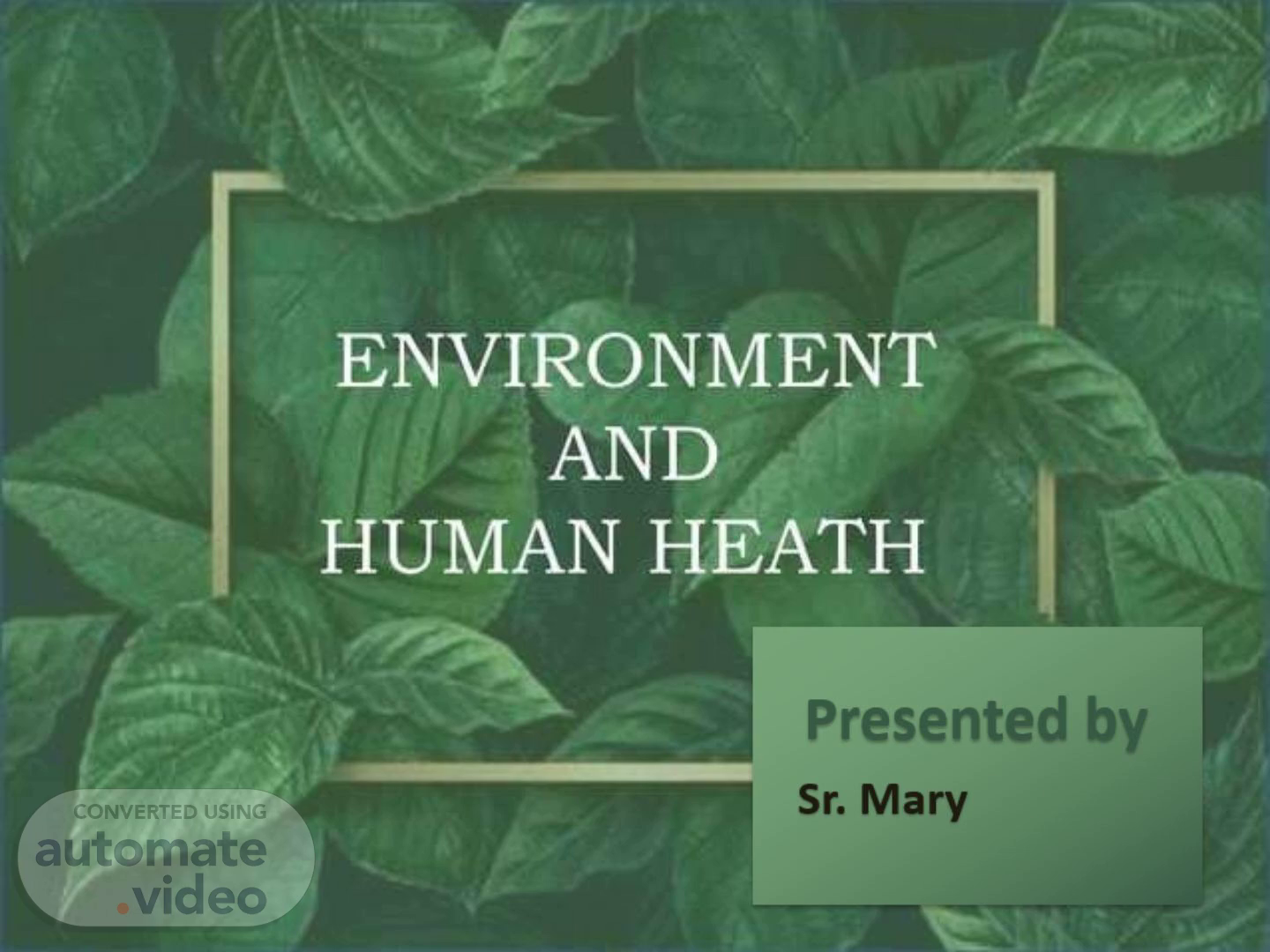Scene 1 (0s)
ENVIRONMENT AND HUMAN HEATH PRESENTED BY : KUNAL MORE.
Scene 2 (8s)
WHAT IS ENVIRONMENT ? • Environment is everything that is around us. It can be living (biotic) or non-living (abiotic) things. It includes physical , chemical and other natural forces. Living things live in their environment. WHAT IS HUMAN HEALTH ? • Health is a state of physica , mental and social well-being in which disease and infirmity are absent.
Scene 3 (25s)
ENVIRONMENT AND HUMAN HEALTH • Environment and human health are intricately related. • A good environment is an indication of healthy human beings and a developed nation. • Now polluted atmosphere has become a serious threat to the very existence of human species. • Pollution growth and intensification of man's activities on various fronts like agricultural development, urbanization and industrialization all over the world have created a hazardous environment. • The environment is under constant interference by human bound activities. • The effect of environment on human health are generally accounted in the following terms : l) The extent to which environmental conditions lead to shortening of life. 2) The extent to which environment induced disability or impairment is found, and 3) The extent to which the biological potential of an individual is reduced..
Scene 4 (55s)
ENVIRONMENTAL FACTORS The various environmental factors which affect human health are : l) Overpopulation 2) Pollution 3) Urbanization 4) Degradation of natural resources.
Scene 5 (1m 4s)
OVER POPULATION Population explosion is the most important cause of all environmental problems. It leads to poverty, over exploitation of resources and environmental degradation..
Scene 6 (1m 13s)
POLLUTION • Any change in the environment which directly or indirectly affects the welfåre of the human beings is called pollution. • But air pollution, water pollution and solid waste pollution are of prime concern. • Other kinds of pollution like nuclear hazards also cause problems related to the health..
Scene 7 (1m 28s)
AIR POLLUTION • Various pollutants present in the air directly affect the different systems of the body • These enter the human body by inhalation or absorption through skin or eyes..
Scene 8 (1m 39s)
WATER POLLUTION • About 70% of the water bodies in the India are polluted. Majority of Indian rivers are dangerously polluted. • The common pollutants are the industrial effluents, municipal wastes, agro- chemicals, oil spills etc. • About 60% water borne diseases are reported in India. It includes typhoid, cholera, bacillary and amoebic dysentery, diarrhea and jaundice..
Scene 9 (1m 56s)
Solid wastes • Discharge of industrial sludges or dumping of industrial and municipal wastes is the prime cause of land pollution. • Such wastes includes garbage, rubbish, hospital refuse, dead animals, agricultural wastes etc. • Chemicals like pesticides, weedicides, insecticides, fungicides etc. used in agriculture, food preservation, community health services • Most of the pesticides are mutagenic and carcinogenic. • Mutagens can cause chromosomal abberations and various kinds of hereditary abnormalities..
Scene 10 (2m 17s)
Hospital refuges are the source of various 'infectious diseases and these act as ideal home for disease carriers or vectors like flies, • insects, bugs, rodents etc. Heavy metals contaminated industrial effluents cause toxicities and varioushealth problems such as fluorosis, minamata disease etc..
Scene 11 (2m 30s)
URBANIZATION • Increase in urbanization adversely affects the ecological balance. It not only causes deforestation but also increases uncontrolled discharge of municipal wastes. • Most Indian cities have about 40% population which leads to deteriorating life quality and poor health services and flourishing of communicablediseases. • These area lack basic amenities anci are disease prone. As such the down trodden areas ofihe cities gre the prime source of infectious diseases.
Scene 12 (2m 49s)
DEGRADATION OF NATURAL RESOURCES l. Loss of natural resources adversely affects the quality of human life, e.g. deforestation results in biodiversity loss because biodiversity is essential for maintaining the basic life supporting process. 2. A number of medicines procured from various life forms are essential for human health..
Scene 13 (3m 4s)
9LOZ MON NAHI MON SA Nar-IJ.
Scene 14 (3m 10s)
Health and Environment linkages Initiative (HELI ) : HELI is a global effort by WHO and UNEP to promote and facilitate action in developing countries to reduce mental threat to human health in support of sustainable development objectives. HELI supports a more coherent approach to valuing the services that ecosystem provide to human health as part of decision making processes. Activities include : • Projects at country level bringing together diverse government and civil society sectors to asses and recommend integrated policies on environment and health issues. • Guidance on better use of impact assessment and economic valuation to enhance environment and health decision making. • capacity building for policy action at local ,national and regional level through technical workshops and interactive events including policy makers, scientists and the public..
Scene 15 (3m 40s)
l. 2. THE CONCLUSION As such clean and green environment is the life of life. A time to take corrective steps is still there, if taken care of. Now a new concept of development is needed that emphasizes the relation between human beings and nature. A sustainable development is the only solution to save human life and health..
Scene 16 (3m 57s)
nox >INVHI.
